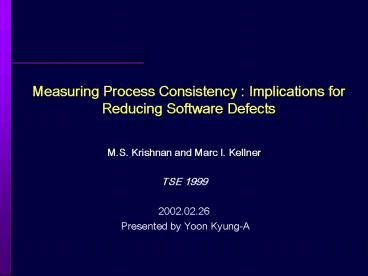Measuring Process Consistency : Implications for Reducing Software Defects - PowerPoint PPT Presentation
1 / 16
Title:
Measuring Process Consistency : Implications for Reducing Software Defects
Description:
Measuring Process Consistency : Implications for Reducing Software Defects ... The problems associated with software development are ... Continuance commitment ... – PowerPoint PPT presentation
Number of Views:33
Avg rating:3.0/5.0
Title: Measuring Process Consistency : Implications for Reducing Software Defects
1
Measuring Process Consistency Implications for
Reducing Software Defects
- M.S. Krishnan and Marc I. Kellner
- TSE 1999
- 2002.02.26
- Presented by Yoon Kyung-A
2
Contents
- Introduction
- Concept of commitment
- Analysis of commitment development model
- Conner and Pattersons model
- Critical misconceptions
- Prescriptions for software process improvement
field - Implications for research
- Implications for practice
- Conclusion
3
Introduction (1)- about Process
- The problems associated with software development
are - Cost and schedule overrun and poor quality
- Caused by the coordination complexity of various
tasks involved in development - Solved by treating the entire development task as
a process - Process
- Can be measured, controlled and improved
- Is a sequence of steps performed for a given
purpose - Software process
- A set of partially ordered activities performed
during the development or evolution of a software
product or system
4
Introduction (2)- about CMM
5
Introduction (3)- about CMM
- In this paper,
6
Empirical model for software defects
- The factors for determining the number of defects
- Product factors
- Both size and nature of the software product
- Quality of the personnel in a software team
- Process factors
- Empirical model outline
- Number-of-Defects
- f (Product Size, Consistent Adoption of CMM
Practices, Personnel Capability)
7
Concept of Commitment (2)- forms of commitment
Meyer and Allens form
- Affective commitment
- Refers to the employees attachment to,
identification with, and involvement within the
entity - I want to
- Continuance commitment
- Refers to an awareness of the costs associated
with leaving or abandoning the entity - I need to
- Normative commitment
- Reflects a feeling of obligation to continue
membership with the entity - I ought to
8
Analysis of commitment model (1)- Conner and
Patersons model overview
9
Analysis of commitment model (2)- Conner and
Patersons model
- Strengths
- Provides many useful tactics or strategies in
times of organizational change - SEI has adopted it for building up commitment
- Weaknesses
- Has the notion of linearity
- Does not contain any references to related
literature - Does not conceptualize the concept of commitment
- Based on anecdotal evidence and experience
- Lack any scientific evidence to support the model
10
Analysis of commitment model (3)- Critical
Misconceptions
- The notion of linearity in the development of
commitment - This models fits with liner, rational assumptions
about the cause and effect sequences - This models fail to acknowledge that commitment
exists in various depth - The controllability of commitment development
process - Commitment process can be influenced, not forced
11
Analysis of commitment model (4)- Critical
Misconceptions(cont)
- The notion of singular commitment construct
- Commitment is a multidimensional construct
- The viewpoint of critical stakeholders can be
turned to the forms of commitment and their
desirability in certain situations - The sole utility aspect of commitment phenomenon
- Later in the article Conner and Patterson remind
that commitment building is time consuming and
expensive
12
Prescriptions for SPI fields (1)- Introductions
- Implications for research
- Implications for practice
13
Prescriptions for SPI fields (2)- Implications
for Research
- SPI researchers should direct their efforts in
conceptualizing the commitment phenomenon - New models of commitment development should be
proposed based on empirical data
14
Prescriptions for SPI fields (3)- Implications
for Practice
- Try to get people volunteering in SPI activities
- Requirement
- Activities to ensure that people are equipped
with enough information to develop a sense of
understanding of SPI - Create an environment enabling commitment to
develop - Open communication, effective collaboration,
taking responsibility, having a shared vision and
an active experimentation
15
Prescriptions for SPI fields (4)- Implications
for Practice (cont)
- Consider getting only critical stakeholders
committed to SPI - The SPI activity should be placed in center of
personal experience - There are people not to commit emotionally even
if it would be highly desirable - Rather than trying to get everyone equally
committed, consider getting only key personnel
committed.
16
Conclusion
- Commitment has been identified as an important
factor in determining the success of SPI
initiatives - Commitment is viewed as a psychological state of
attachment that defines the relationship between
a person and entity - By identifying common misconceptions in existing
commitment models, this paper suggests the
prescription for SPI fields































